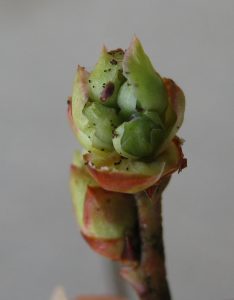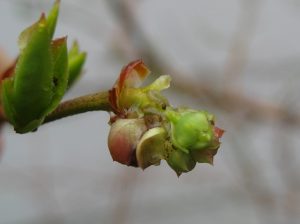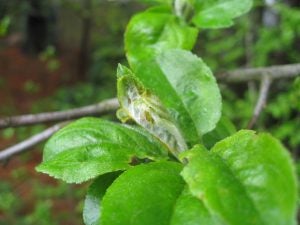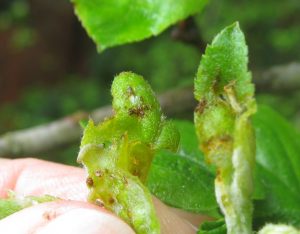Winter moth and apple update
Just a quick update on winter moth. It’s a good time to check your blueberries and see whether or not you find winter moth caterpillars. Look on the top of blueberry buds for insect frass (droppings). Consider spraying Bt or a spinosad product (Captain Jack’s Deadbug Brew, Delegate, or Conserve) if you find much damage. Don’t use spinosad if buds are close to opening. Bt is safe to use on open flowers since it does not harm bees.


Winter moth frass on blueberry bud. Blueberry bud pulled apart and see caterpillar.


Winter moth frass on blueberry bud. Blueberry bud pulled apart and see caterpillar.
I haven’t done much scouting around the state, but I have not seen any areas with a high population of winter moth caterpillars. Caterpillars are still small and I haven’t been many places. If you see areas with a lot of damage please let me know.

Apples
Just a quick update – At this time no fire blight infection is predicted over the weekend according to Orchard Radar. Check out the two fire blight models on Orchard Radar through bloom. Select either the Greenville or Newport County site, which ever is closer to your orchard.
Check your apple leaves and buds for winter moth damage. It’s often easier to find frass than winter moth caterpillars. Most caterpillars I found today were inside stuck or folded leaves. See attached pictures. If you are finding much damage consider applying a Bt insecticide such as DiPel.


Damaged apple leaves from winter moth. Apple leaves pulled apart and see small caterpillars.
The New England Tree Fruit Management Guide on-line version is available at
https://ag.umass.edu/fruit/new-england-tree-fruit-management-guide
https://ag.umass.edu/fruit/new-england-tree-fruit-management-guide
 Home
Home Browse
Browse Close
Close Events
Events Maps
Maps Email
Email Brightspace
Brightspace eCampus
eCampus


